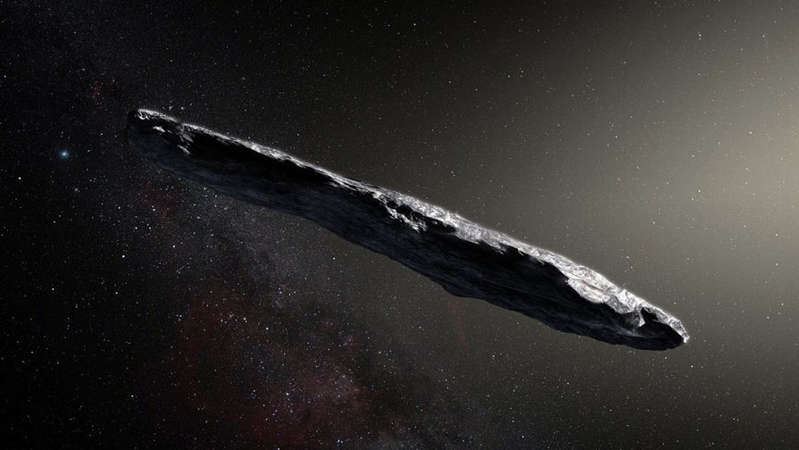
Scientists estimate the lifespan of interstellar objects
A new study by German, Korean and American scientists has shown that erosion caused by cosmic radiation severely limits the lifespan of icy interstellar asteroids like Oumuamua and Comet Borisov. Although there may be many more interstellar objects initially icy, they usually simply cannot live long enough to reach other star systems. An article about this has been published on the arXiv.org preprint site, but has not yet been reviewed. The lead author is Vo Hong Minh Phan of the University of Aachen in Germany.
So far, only two interstellar objects that have visited the solar system are known. These are Oumuamua and comet 2I / Borisov. There is also a third possible candidate, designated CNEOS 2014-01-08.
Previous research has shown that Oumuamua may be a remnant of an icy object from another star system, similar to Pluto. In this scenario, Oumuamua was born somewhere in the Perseus arm about 0.5 billion years ago. The original diameter of Oumuamua could be 10-50 km – it all depends on how intensely he was bombarded by cosmic rays during his interstellar journey.
Four types of ice objects were considered: consisting of nitrogen (N2), carbon monoxide (CO), carbon dioxide (CO2) and methane (CH4). Cosmic rays in the interstellar medium have different erosional effects on these types of ice. The impact on interstellar ice objects of collisions with surrounding gas in the interstellar medium was also considered. The impact of cosmic rays can vary greatly, respectively, and the erosion time for different objects can also vary greatly depending on the cosmic ray fluxes. The same is true for interstellar gas.
For objects that have arisen at distances of about 16 thousand light years and moving at a speed of 10 km / s, their minimum initial dimensions should be from 3 to 10 km for ordinary types of ice and methane, provided that the cosmic ray flux is similar to our local one. With more intense streams of cosmic radiation, the range of occurrence of such objects decreases to 13 thousand light years.
On the other hand, one can consider all the options for the formation of ice objects, estimate their initial size and thus establish how far they could eventually move away from their place of origin, depending on the speed. The effect of erosion from collisions with gas inside the stellar system is the stronger, the higher the speed of the object. However, on the other hand, the slower an icy asteroid moves, the longer it is exposed to cosmic rays, which means that it must collapse more strongly.
In the above graph, the object's velocity is plotted horizontally, and the maximum distance to the place of birth is plotted vertically for two different variants of the intensity of the effect of cosmic rays. Only objects with a radius of 10 km are considered in the graph. The green vertical line corresponds to the object's speed of 10 km / s, which is comparable to the speed of Oumuamua.
This kind of research is still at an early stage. Among the authors of this work is the famous astrophysicist Abraham Loeb, who has recently come forward with many overly bold, in the opinion of a number of his colleagues, hypotheses. So, in November 2018, he suggested that Oumuamua could be a probe deliberately sent to Earth by an alien civilization.
Oumuamua was discovered in October 2017, when it was 30 million km from Earth. This object was originally thought to be a comet but was soon reclassified as an alien asteroid. Oumuamua has a cigar-like shape – its length (about 400 m) is ten times its thickness. According to astronomers, such an elongation of forms has never been encountered among comets or asteroids in the solar system. According to the results of spectroscopy, astrophysicists suggested that the asteroid is composed of ice and covered with an ice crust rich in organic matter.
Comet 2I / Borisov is the first interstellar comet discovered by amateur astronomer Gennady Borisov on August 30, 2019 using a 65-cm telescope of his own design and later discovered in images from the Hubble Space Telescope.
The authors of the new work note that more information is needed about how cosmic rays affect interstellar ice objects in order to confidently retrace their route. “It is also clear from this example that a more detailed study of the spatial profile of galactic cosmic rays could help shed light on the origin of interstellar objects passing through the solar system,” they write.
“It would be useful to conduct detailed simulations of the distribution of cosmic rays in the galactic disk in order to establish more stringent restrictions on the birthplace of known interstellar asteroids. This would help us clarify their origins, ”the study authors conclude.
As new observation means, observatories and space instruments appear in the next few years, we will definitely discover more and more such objects, and even when they just appear on the borders of the solar system, and someday to one of the an automatic interplanetary station will go to intercept them. Vyacheslav Turyshev, a leading researcher at the NASA Jet Propulsion Laboratory, spoke about this in an interview.
ESA plans to launch the Comet Interceptor mission in 2029. This device will be located at the L2 Lagrange point of the Sun-Earth system and will wait. He can spend three years there and wait for the arrival of an attainable long-period comet. Then he can be sent to study this comet. A similar interceptor can also be used to study interstellar objects, but there is another project specifically conceived for the study of interstellar asteroids – Project Lyra. It is an interplanetary station with a state-of-the-art nuclear power plant, which also uses Jupiter's gravity in order to use this gravitational maneuver to accelerate and quickly get into the outer part of the solar system.

